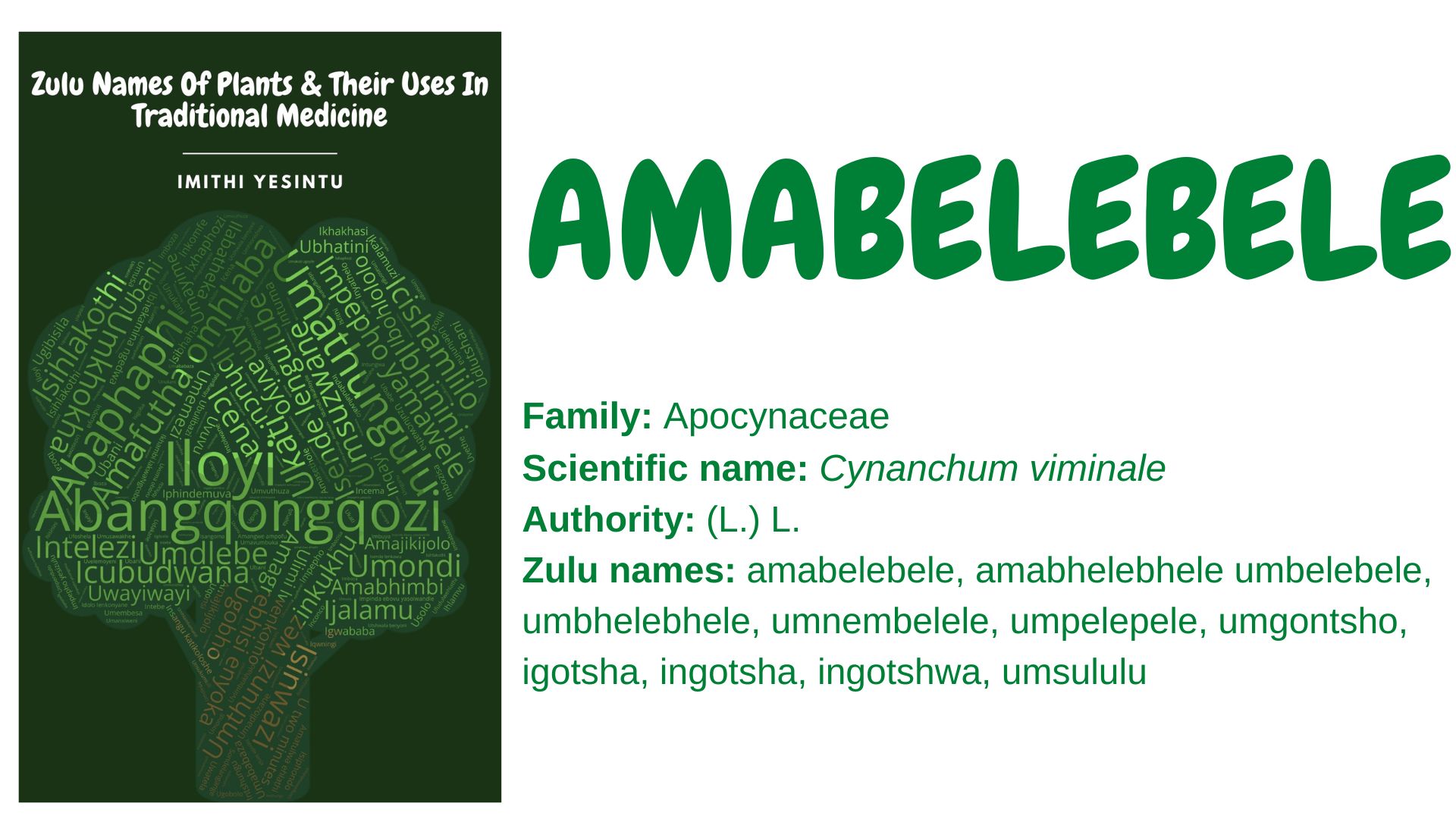Family: Apocynaceae
Scientific name: Cynanchum viminale
Authority: (L.) L.
Synonyms: Asclepias aphylla Thunb., Asclepias nuda Schumach. & Thonn., Cynanchum aphyllum (L.) L., Cynanchum aphyllum (Thunb.) Schltr., Decanemopsis aphylla Constantin & Gallaud, Euphorbia viminalis L., Sarcostemma viminale (L.) R.Br.
Zulu names: amabelebele, amabhelebhele umbelebele, umbhelebhele, umnembelele, umpelepele, umgontsho, igotsha, ingotsha, ingotshwa, umsululu
Other names: caustic bush, caustic creeper, caustic vine, creeper (English) melktou, melktoubos, melktoubossie, wolfsmelk, spantou, spantoumelkbos, spantou-melkbos (Afrikaans)
Plant description: C. viminale is a climbing succulent that can grow up to 5 m in height. It is leafless with sweetly scented star-shaped yellowish flowers and a thin green stem that oozes a milky sap when cut or damaged. The succulent grows in the arid and semi-arid regions that have well-drained soils.
Uses:
- The edible young stems and fruits are eaten as food.
- The succulent most likely gets the “amabelebele”, which translates to breasts, from the fact that it oozes a milky sap like breasts. Addedly, the name is due to the plant being used to increase milk production for breastfeeding mothers after giving birth.
- This plant is also used to increase the milk production in cattle.
- The sap of this plant is used to treat an eye infection that is caused by the sap of Euphorbia ingens E.Mey. ex Boiss. getting into and infecting the eyes.
- The plant is used to make a literal rope.
- The plant is used to make intelezi that is considered as a figurative rope that is used to tie down your enemies.
- The stem is used to treat abdominal pains, diarrhoea, ulcers, and intestinal tumours.
- The plant is used to treat hypertension and heartburn.
- The plant is used to treat smallpox and septic wounds and sores.
- The sap is used to treat swelling in the body.
- The plant is used to treat eye infection.
- The plant is used as a diuretic.
- The plant is used to treat venereal diseases such as gonorrhoea and pain from urination.
- The plant is used as a mole repellent.
Safety precaution:
Using traditional medicine responsibly can enhance your overall health and well-being. Misuse and abuse can lead to complications. You can inquire about the correct use of traditional medicine from a knowledgeable herbalist and practitioner. You can also visit imithiyesintu.co.za or email: info@imithiyesintu.co.za to learn more about traditional medicine
References and further reading:
- Boon, R., 2010. Pooley’s Trees of Eastern South Africa: A Complete Guide. Flora & Fauna Publications Trust, Durban.
- Corrigan, B.M., Van Wyk, B.E., Geldenhuys, and C.J., Jardine, J.M., 2011. Ethnobotanical plant uses in the KwaNibela Peninsula, St Lucia, South Africa. South African Journal of Botany 77, pp. 346–359.
- De Wet, H., Nkwanyana, M.N., and Van Vuuren, S.F., 2010. Medicinal plants used for the treatment of diarrhoea in northern Maputaland, KwaZulu-Natal Province, South Africa. Journal of Ethnopharmacology 130, pp. 284–289.
- De Wet, H., Ramulondi, M., and Ngcobo, Z.N., 2016. The use of indigenous medicine for the treatment of hypertension by a rural community in northern Maputaland, South Africa. South African Journal of Botany 103, pp. 78–88.
- Fox, F.W., and Norwood Young, M.E. 1982. Food from the veld. Delta Books, Johannesburg.
- Hutchings, A., Scott, A.H., Lewis, G., and Cunningham, A.B., 1996. Zulu Medicinal Plantsௗ: An Inventor\. University of Natal Press, Pietermaritzburg.
- Moteetee, A. and Seleteng Kose, L. 2017. A review of medicinal plants used by the Basotho for treatment of skin disorders: their phytochemical, antimicrobial, and anti-inflammatory potential. The African Journal of Traditional Complementary and Alternative Medicines.14, pp. 121–137
- Malatji, K.P., 2019. An Ethnobotanical Survey of Medicinal Plants Used for the Treatment of Heartburn in Southern Africa and an Evaluation of Their Pharmacological and Chemical Properties. University of Johannesburg (South Africa).
- Mbanjwa, S.G., 2020. A quantitatrive ethnobotanical survey of the Ixopo area of KwaZulu Natal, South Africa.Dissertation. Johannesburg: University of Johannesburg. Available from: http://hdl.handle.net/102000/0002 (Accessed: 10 May 2023)
- Mhlongo, L.S. 2019. The medicinal ethnobotany of the Amandawe area in KwaCele, KwaZulu-Natal, South Africa. Johannesburg: University of Johannesburg. Available from: http://hdl.handle.net/102000/0002 (Accessed: 22 February 2023).
- Mhlongo, L.S., and Van Wyk, B.E., 2019. Zulu medicinal ethnobotany: new records from the Amandawe area of KwaZulu-Natal, South Africa. South African Journal of Botany 122, 266±290. https://doi.org/10.1016/j.sajb.2019.02.012
- Pooley, E., 2006. Forest plants in the forest and in the garden: Popular guides to the biomes of South Africa. The Flora Publication Trust, South Africa.
- Umberto Quattrocchi “CRC World Dictionary of Medicinal and Poisonous Plants: Common Names, Scientific Names, Eponyms, Synonyms, and Etymology” (5 Volume Set) CRC Press, 03/May/2012
- Focke Albers, Ulrich Meve “Illustrated Handbook of Succulent Plants: Asclepiadaceae: Asclepiadaceae” Volume 4 Springer, 2002.
You Can Order Your Copy Of The Book By Emailing: info@imithiyesintu.co.za
Feel Free To Add Other Uses Of This Plant In The Comment Section Below:
